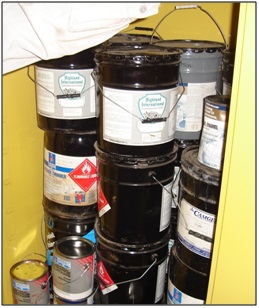Hazardous Materials Storage

Description
Failure to properly store hazardous materials dramatically increases the probability that they will end up in local waterways. Many people have hazardous materials stored throughout their homes, especially in garages and storage sheds. Practices such as covering hazardous materials or storing them properly can have dramatic impacts.
Applicability
Hazardous material storage is relevant to both urban and rural settings and all geographic regions. The effects of hazardous material leakage may be more pronounced in areas with heavier rainfall, due to the greater volume of runoff.
Siting and Design Considerations
EPA (1992) has outlined some management considerations for hazardous materials. They are as follows:
- Ensuring sufficient aisle space to provide access for inspections and to improve the ease of material transport.
- Storing materials away from high-traffic areas to reduce the likelihood of accidents that might cause spills or damage to drums, bags, or containers.
- Stacking containers in accordance with the manufacturers' directions to avoid damaging the container or the product itself.
- Storing containers on pallets or equivalent structures. This facilitates inspection for leaks and prevents the containers from coming into contact with wet floors, which can cause corrosion. This consideration also reduces the incidence of damage by pests (insects, rodents, etc.).
- Delegating the responsibility for management of hazardous materials to personnel trained and experienced in hazardous substance management.
Covering hazardous materials and areas where such materials are handled reduces potential contact with stormwater and wind. Storage areas, outdoor material deposits, loading and unloading areas, and raw materials should all be covered or enclosed. Priority should be given to locations of the most hazardous materials (USEPA 1992).
Residents waiting to dispose of their household hazardous materials should store them properly until their hazardous waste collection day (See
Proper Disposal of Household Hazardous Wastes fact sheet). An example storage technique includes a plastic container with a lid (e.g., a 5-gallon bucket). The container should be filled halfway with (unused) kitty litter. Then the hazardous material, in its own, original container, can be put into the bucket. The bucket lid must be fastened and the container clearly marked. It should be stored away from children and anyone else who might ingest the hazardous material stored inside. To reduce the potential for corrosion, the container should be stored off the ground.
Limitations
The lifespan of the cover or structure must be taken into account, depending on the hazardous nature of the stored materials. Tarpaulins and plastic sheets may not last in certain types of climatic conditions. If a roof or other structure is required, the lifespan will increase. Any storage facility must meet local fire and building codes (Ferguson, et al. 1997).
Maintenance Considerations
Maintenance of hazardous material storage areas consists mostly of inspection and employee training (Ferguson, et al. 1997). Storage spaces and containers should be routinely inspected for leaks, signs of cracks or deterioration, or any other signs of leakage.
Effectiveness
Proper storage of hazardous materials reduces the possibility of contamination of stormwater runoff and receiving waters when coupled with proper maintenance techniques.
Cost Considerations
Estimates of costs for storing and covering hazardous materials vary depending on the substance and type of operation. Ferguson et al. (1997) estimated the costs of a pre-fabricated building at $6 to $11 per ft2, and the cost of a 6-inch thick concrete slab at $3.50 to $5.00 per ft2. All hazardous materials should be protected from exposure to stormwater regardless of the expense. To offset the cost of covering or enclosing hazardous materials, consider changing procurement, inventory, and disposal practices to minimize the amount of materials stored onsite.

See MassDEP's
Hazardous Household Products: Handling & Management
References
Ferguson, T., R. Gigac, M. Stoffan, A. Ibrahim, and H. Aldrich. 1997.
Rouge River National Wet Weather Demonstration Project. Wayne County, MI.
USEPA. 1992.
Stormwater Management for Industrial Activities. U.S. Environmental Protection Agency, Office of Water, Washington, D.C.